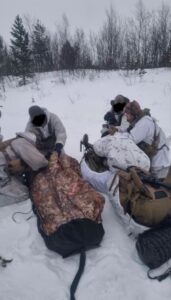
Story by Kirk Frady
Medical Readiness Command, Europe
Porsangmoen Camp, Norway – Sgt. Miles Atkins, a combat medic assigned to the U.S. Army Health Clinic Grafenwoehr, Germany, braved sub-zero temperatures while taking part in the NATO Cold Weather Combat Medic Instructor Course in Norway Nov. 28 to Dec. 13.
Atkins was among a group of several NATO participants taking part in the two-week long medical training event at the Cold Weather Operations Centre of Excellence in Porsangmoen Camp, Norway.
The rigorous medical instructor course provided participants the skills and knowledge required to prepare, plan, and execute medical operations in arctic winter temperatures of minus 40 degrees Fahrenheit or greater.
“I wanted to push my medical training and skills outside the environments I previously fought and trained in,” said Sgt. Atkins. “As a result of this training, I received lots of exposure to other NATO medical forces and their routines and practices. I now look forward to sharing the knowledge and lessons I learned from this training with my fellow Soldiers.”
Atkins and the other NATO participants were able to complete a total of 74 Individual Critical Tasks (ICTs) during the strenuous training. For U.S. Army combat medics, there are approximately 124 Individual Critical Tasks they must master to maintain their skills and efficiency.
“I am extremely grateful to have had the opportunity to experience formal instruction and hands-on training under such harsh weather conditions,” Atkins added. “I now feel confident that I can operate efficiently in the mountains, the desert, the jungle and the arctic, without compromising Soldier safety.”
The Cold Weather Combat Medic Instructor Course in Norway provides students with practical experience and knowledge on how to conduct their own medical operations and training in a cold weather climate.
“This training forced us to analyze our required supply levels, the terrain, medical evacuation procedures and associated timelines, rest and work cycles, the condition of our troops, and proficiency of our own skills,” said Atkins. “One of the major points driven home during the training had to do with prolonged field care. This is due to the slow nature of most physical actions and responses when operating in colder climates like Norway.”
As part of the training, participants acquire knowledge and skills on utilizing Tactical Combat Casualty Care drills in winter conditions and learn how to prevent, recognize, and treat cold weather injuries and adapt their own equipment to best function in cold a weather climate. The course emphasizes practical exercises and demonstrations including two field exercises with a total of 8 nights spent in a field environment.
As with any military training, critical lessons were learned by the those attending the training.
“One of the biggest lessons I learned from the training is to avoid overpacking,” Atkins added. “I carried way too much stuff. I also realized that you need to be physically fit. You must be prepared to move long distances on foot on short notice with all your equipment and to carry casualties over mountainous and snow-covered terrain. Overall, this was a tremendous learning opportunity, and I am thankful to have taken part. I would highly recommend it to any Soldier wanting to expand their skill sets and levels of proficiency.”